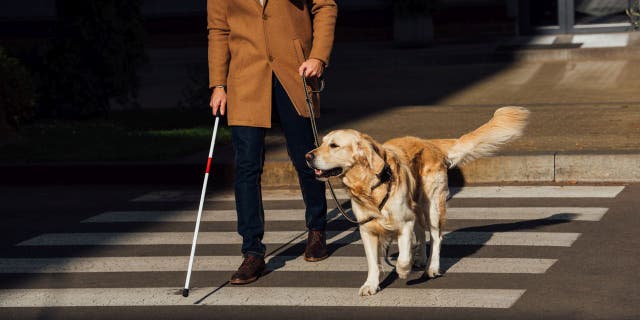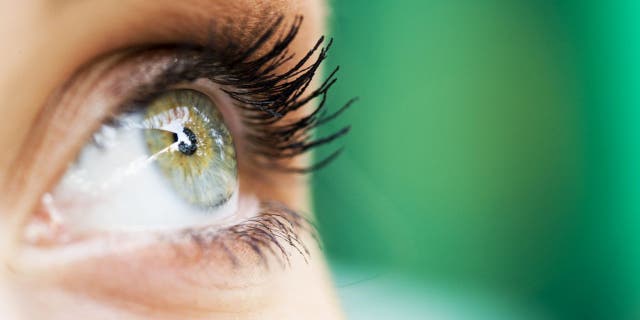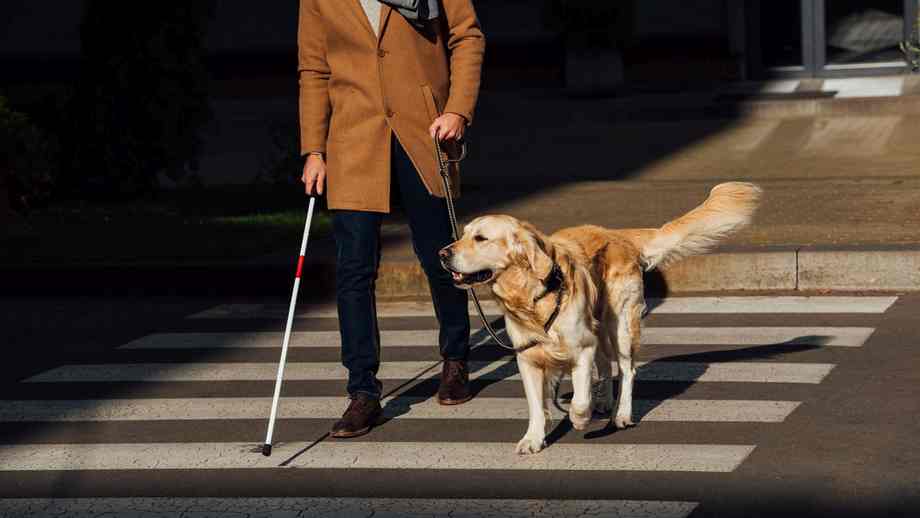In a paper revealed Monday within the journal Nature Drugs, researchers working with the Paris-based firm GenSight Biologics SA reported {that a} 58-year-old man who was identified with retinitis pigmentosa 40 years in the past was in a position to find objects positioned on a desk after receiving an experimental remedy. And New York Metropolis-based firm Bionic Sight LLC introduced in March that 4 blind individuals in an early-stage medical trial at the moment are in a position to detect mild and movement after present process the same therapy. These outcomes haven’t but been revealed.
The sufferers all had superior instances of retinitis pigmentosa, which impacts greater than two million individuals world-wide. All underwent optogenetic remedy, through which an injection is used to ship a gene into the attention to spice up the sunshine sensitivity of sure cells within the retina, a layer of tissue behind the attention. The businesses are growing high-tech goggles that course of and amplify mild in a approach that enhances the cells’ potential to ship electrical indicators to the mind.
DEPRESSION ALTERS VISUAL PROCESSING, STUDY SUGGESTS

Scientists are making dramatic strides towards a objective that when appeared virtually unimaginable: Restoring restricted imaginative and prescient to individuals affected by a beforehand irreversible type of blindness brought on by an inherited eye illness referred to as retinitis pigmentosa. (iStock)
Dr. Anand Swaroop, a senior investigator on the Nationwide Eye Institute in Bethesda, Md., referred to as optogenetic remedy an thrilling choice for some blind individuals however not a treatment. As soon as sight is misplaced fully, he mentioned, “Restoring imaginative and prescient that permits excessive decision, excessive sensitivity, and excessive detection will not be easy.”
How Optogenetics Tries to Restore Partial Imaginative and prescient
An experimental approach has been proven to revive partial imaginative and prescient in individuals blinded by a hereditary eye illness generally known as retinitis pigmentosa.
In regular imaginative and prescient, mild hits the retina behind the attention. Photoreceptor cells there convert the sunshine into electrical indicators that journey by the retina to the ganglion cells. The ganglion cells then ship the indicators by way of the optic nerve to the mind. The mind turns these indicators into photos.
Retinitis pigmentosa causes the photoreceptor cells to interrupt down, leading to imaginative and prescient loss.
Latest experiments with optogenetic therapies are beginning to present some restoration of imaginative and prescient. The therapies ship a gene to the ganglion cells that makes them delicate to mild.
Sufferers then put on particular goggles, which course of the sunshine…
…and amplify it to assist the ganglion cells ship electrical indicators to the mind.
Barry Honig, a participant within the Bionic Sight trial, mentioned that folks had usually requested him if he would love to have the ability to see once more. “That is the primary time I’ve felt it’s attainable,” he mentioned.
A 59-year-old father of three dwelling in Tenafly, N.J., Mr. Honig mentioned that assessments following the therapy confirmed he was in a position to determine objects by sight—distinguishing, for instance, the curved form of a banana from the rounder form of an apple. He mentioned he was stunned by the advance in his imaginative and prescient. “Think about you spend a very long time in a darkish tunnel and abruptly you’re again within the mild,” he mentioned. “You must modify.”
RESEARCHERS IDENTIFY 50 ADDITIONAL GENES FOR EYE COLOR

New York Metropolis-based firm Bionic Sight LLC introduced in March that 4 blind individuals in an early-stage medical trial at the moment are in a position to detect mild and movement after present process experimental remedy. (iStock)
GenSight mentioned it is usually growing the remedy as a therapy for macular degeneration, a number one reason behind imaginative and prescient loss in individuals over age 50. As much as 11 million individuals within the U.S. endure from the situation, in response to the Clarksburg, Md.-based nonprofit BrightFocus Basis, which funds analysis on mind and eye illnesses.
The usage of gene remedy to deal with blindness isn’t new. Luxturna, a prescription medication permitted in 2017 by the U.S. Meals and Drug Administration, is utilized in kids and adults with a type of retinitis pigmentosa brought on by a particular genetic mutation. Editas Drugs of Cambridge, Mass., is testing Crispr gene modifying in retinitis pigmentosa sufferers with a distinct gene mutation.
However retinitis pigmentosa could be brought on by mutations in additional than 70 totally different genes, and docs say it’s too pricey and troublesome to develop a gene remedy for all of them. “All these sufferers are omitted,” mentioned Dr. Sheila Nirenberg, professor at Weill Medical Faculty of Cornell College and Bionic Sight’s founder. “What about them?”
Optogenetics presents the power to deal with blindness brought on by retinitis pigmentosa whatever the particular gene mutation that underlies it. “It’s gene-agnostic,” mentioned Dr. Brian Brooks, medical director of the Nationwide Eye Institute.
SOME CORONAVIRUS PATIENTS LEFT WITH NODULES ON EYEBALLS, STUDY FINDS
Restoring imaginative and prescient is a vital objective for scientists and clinicians, and lots of different methods are being pursued in tutorial labs and firms—together with bionic eyes and stem-cell therapies along with medication and optogenetics.

Stem-cell remedy is one choice scientists are researching to reverse blindness brought on by genetic circumstances. (iStock)
In regular imaginative and prescient, light-sensitive cells within the retina generally known as photoreceptors convert mild into electrical indicators that journey to close by ganglion cells. These cells then ship the indicators by way of the optic nerve to the mind, which turns them into visible perceptions. In retinitis pigmentosa and related hereditary retinal problems, the photoreceptors break down and cease working.
Optogenetic remedy will get round that drawback by bypassing the photoreceptors, utilizing the injected gene to confer mild sensitivity to the ganglion cells that reply to mild beamed into the attention by the goggles.
Vedere Bio Inc. is pursuing a model of optogenetic remedy that doesn’t require goggles. Novartis acquired Vedere Bio, primarily based in Cambridge, Mass., final yr and hopes to launch a medical trial, mentioned Dr. Cynthia Grosskreutz, vice chairman and world head of ophthalmology on the Novartis Institutes for BioMedical Analysis.
CLICK HERE FOR FULL CORONAVIRUS COVERAGE
“On the finish of the day the objective is to get it to sufferers that want it,” she mentioned. “The simpler it’s for the remedy to be administered, the extra sufferers may have entry to the therapies.”
Within the GenSight trial, an unnamed 58-year-old Frenchman acquired the optogenetic injection in a single eye and was educated to make use of the goggles. In assessments administered 4½ months after the injection, the person was in a position to understand and rely gadgets positioned earlier than him on a desk. Ten months after the injection, he felt comfy utilizing the goggles outdoors, telling the researchers accompanying him that he may see the white stripes of crosswalks, in response to Dr. José-Alain Sahel, an ophthalmologist on the College of Pittsburgh and Sorbonne College and an writer of the Nature Drugs paper.

Within the GenSight trial, an unnamed 58-year-old Frenchman acquired the optogenetic injection in a single eye and was educated to make use of the goggles. (iStock)
The present model of the optogenetics know-how has some limitations, in response to the scientists behind the analysis. Solely a small portion of the sufferers’ ganglion cells have been handled, limiting the potential profit. The handled sufferers aren’t anticipated to regain all of their misplaced eyesight—they will’t learn, drive or acknowledge faces.
“It isn’t regular imaginative and prescient,” mentioned Dr. Botond Roska of the College of Basel and the Institute of Molecular and Medical Ophthalmology Basel, an skilled within the research of imaginative and prescient and the retina and one other writer of the paper. “Nevertheless it provides hope to revive imaginative and prescient that’s significant.”
CLICK HERE TO GET THE FOX NEWS APP
Mr. Honig, the daddy who participated within the Bionic Sight trial, began utilizing a information canine at 16. His imaginative and prescient dramatically deteriorated over the many years to the purpose that he may barely see mild.
Months after receiving the injection, he mentioned he has seen enhancements in his imaginative and prescient even with out the goggles. He can see the form of a cup when he brings it near his mouth to take a drink. Looking the window, he can inform if the solar is out. He doesn’t count on to ever be capable of drive. However sometime, he mentioned, he hopes the know-how will enhance sufficient to permit him as soon as once more to see his spouse’s darkish hair and get not less than a tough image of his kids’s faces.
“I’m not visually grasping,” Mr. Honig mentioned. “That might be wonderful.”
To learn extra from The Wall Road Journal, click on right here.












